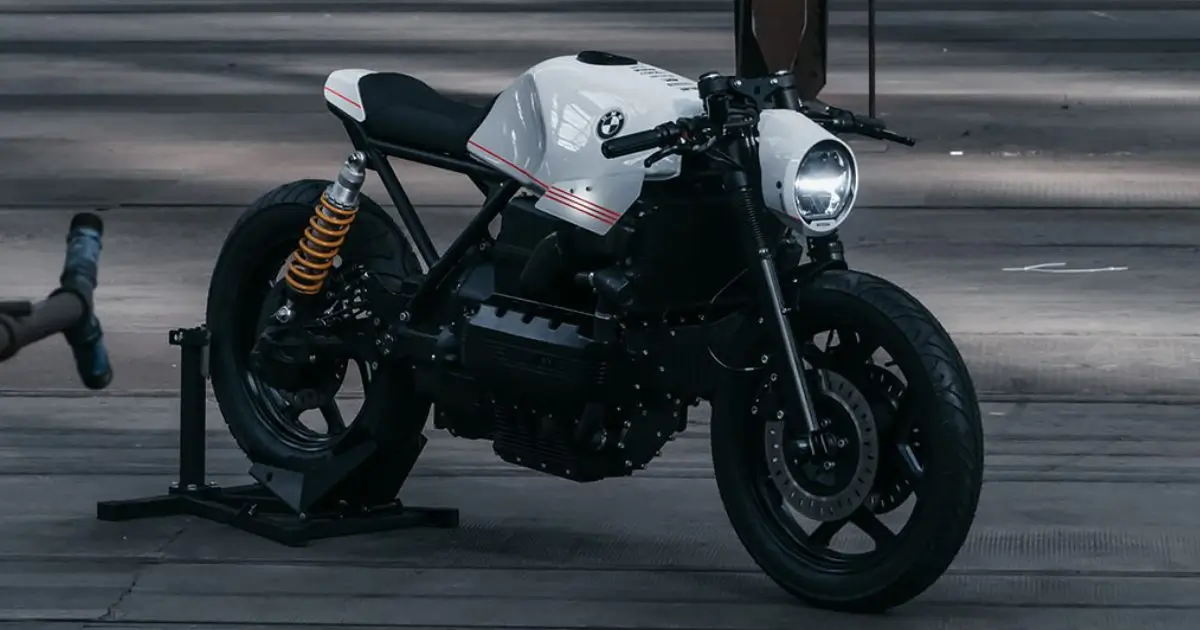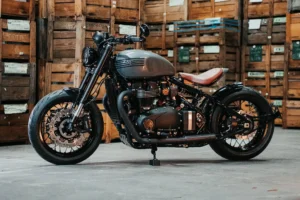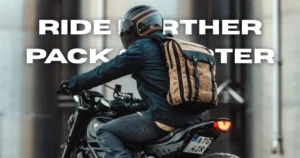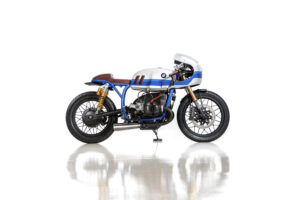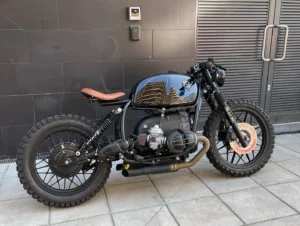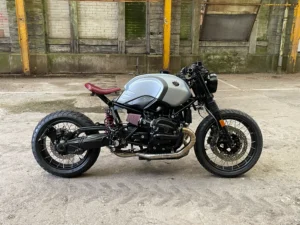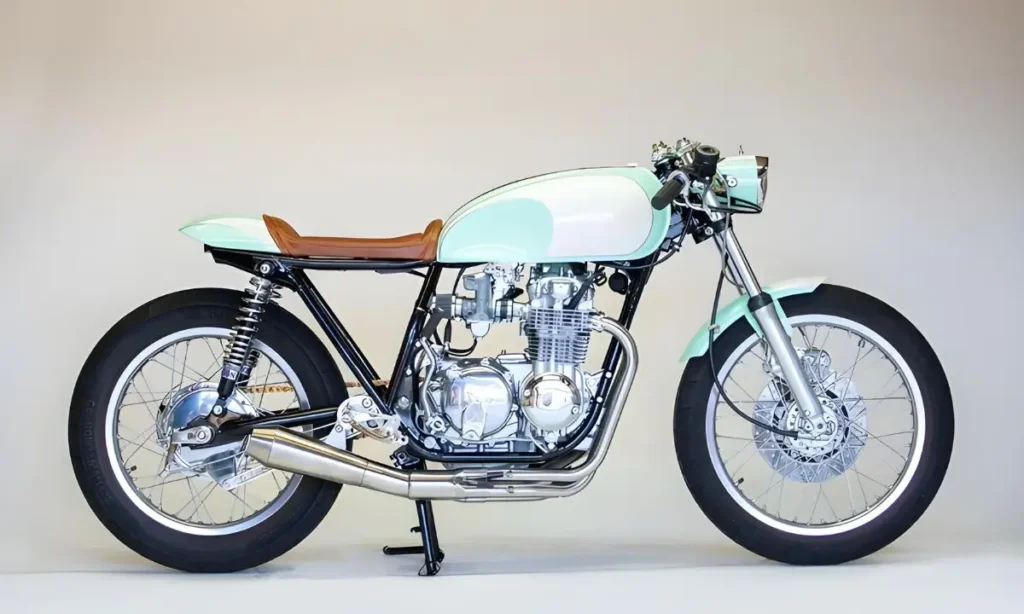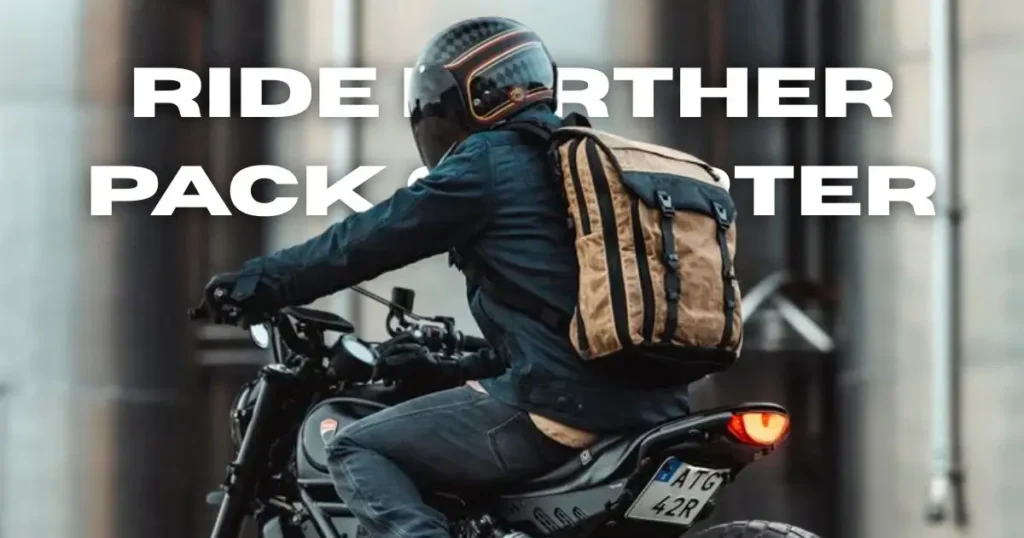Table of Contents
ToggleThe BMW K100 was never the easiest motorcycle to customize. Its boxy engine, angled frame, and awkward rear made it a difficult base for clean café racer builds. But Motoism and Impuls, two builders from Munich, saw something different. They chose to highlight the bike’s unusual shape instead of hiding it. The result is a sharp, futuristic 1983 BMW K100 café racer designed for both form and function. This build is more than a one-off project. It is a test platform for a full custom kit, using digital tools and 3D-printed parts to bring new life to an old machine.
Motoism x Impuls: Munich-Based Design Innovators
This 1983 BMW K100 café racer is a joint project by Motoism and Impuls, two custom motorcycle builders based in Munich. Both teams focus on modern design and precision-made parts. They share a clear approach built around clean lines and functional upgrades.
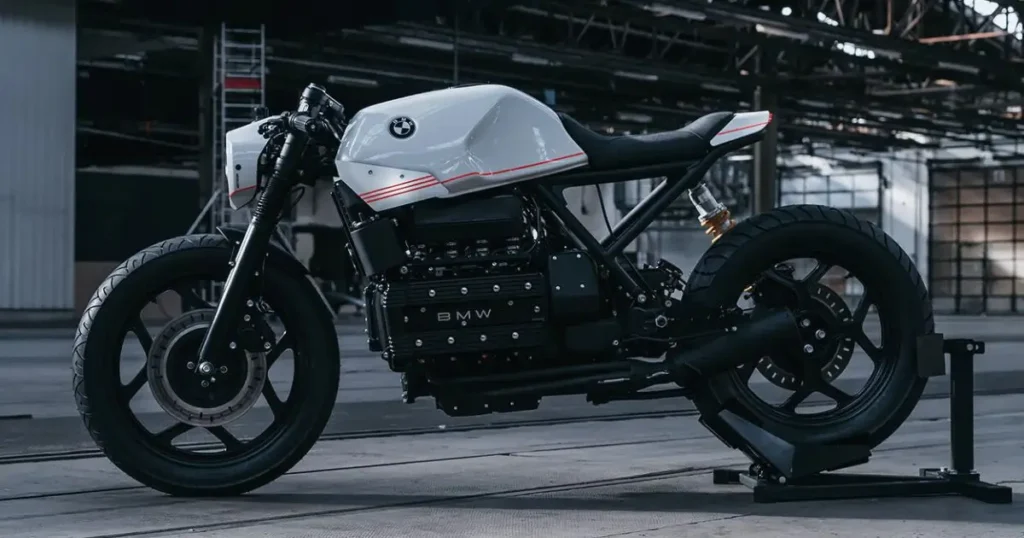
Their goal was to create a complete custom build and develop a parts kit that others could use. Every part was designed with accuracy to fit the K100 platform. The team used digital tools and fabrication methods to support the project.
They received support from several partners, including VOR Shoes, Kruno Trim Studio, Öhlins, ABM, and Pirelli. Each brand contributed components or technical help. The result reflects collaboration, sharp design, and high-quality build standards.
3D Scanning to Ride-Ready: A Fully Digital Build Path
Motoism and Impuls approached this 1983 BMW K100 café racer with a fully digital workflow. Their goal was not only to create a unique machine but also to develop repeatable parts. The process started by stripping the bike down to its frame. Once the structure was bare, they scanned it in 3D to capture every detail.
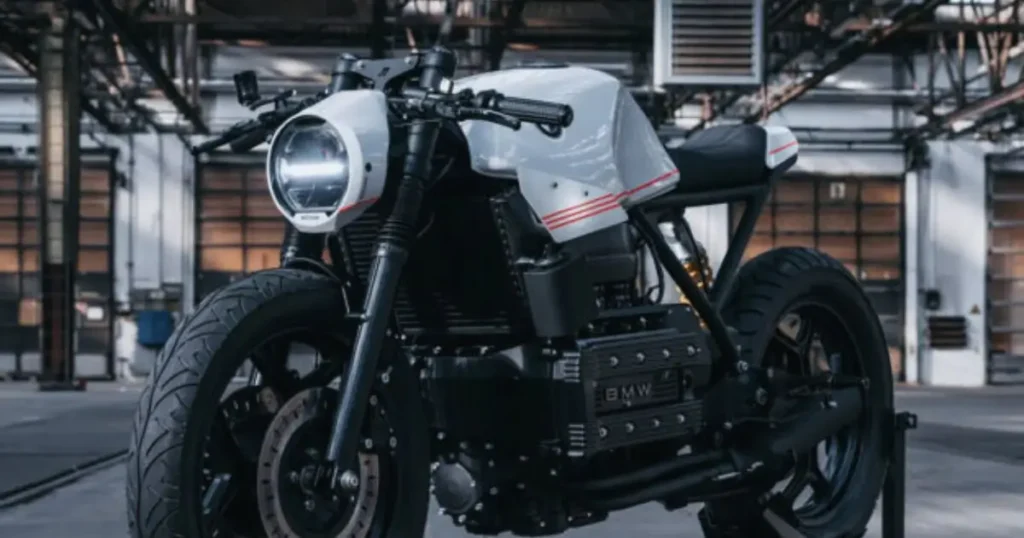
Using the digital model, they redesigned the entire bike on screen. Key elements like the headlight nacelle, aero wings, and tail section were reshaped digitally before any parts were made.
All components were produced with advanced 3D printing. The materials included a strong copolymer and a carbon-reinforced version for added durability. These parts were made to fit the K100 precisely and could be installed without extra modification.
This process made it easier to test, align, and finalize parts with accuracy. It also allowed the team to create a modular kit that others can use. For custom builders, this approach provides both design freedom and production efficiency.
From Wings to Tail: Signature Visual Elements
The visual identity of this 1983 BMW K100 café racer begins at the front. A custom headlight nacelle, made from 3D-printed components, is mounted using laser-cut stainless steel brackets. It houses a Koso Thunderbolt LED headlight at the center. Above it sits a compact Motogadget digital speedometer, paired with a slim row of LED warning indicators. The ignition system is fully keyless, activated through an RFID sensor hidden within the nacelle.
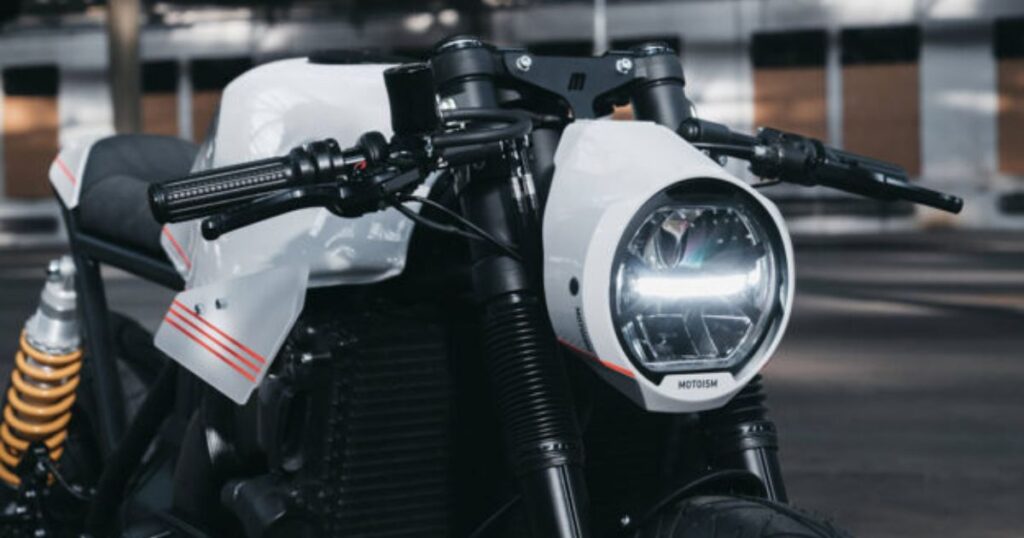
On each side of the original fuel tank, Motoism and Impuls added translucent wing panels. These elements do not improve aerodynamics. Instead, they serve as illuminated daytime running lights. Internal LEDs give them a soft glow that adds visibility and reinforces the bike’s modern look. Stainless steel brackets connect the wings to the tank securely.

Lower down, a short 3D-printed front fender hugs the tire closely. It is mounted with precision-cut stainless brackets. Motoism also created custom fork covers with integrated LED turn signals. These remain hidden when off, preserving a clean front profile.
At the rear, a welded subframe supports a single-seat setup with a cleanly upholstered saddle. Behind it, a 3D-printed rear cowl forms the tail. The taillight design features a set of translucent plastic fins lit from within by LEDs. These fins give the rear a distinctive light signature that blends safety with design.
Every visual feature, from the illuminated wings to the sculpted tail, is part of a unified styling approach. The elements connect front to rear with clear intent and consistent design language.
Precision-Built Subframe and Suspension Tweaks
Motoism and Impuls made key changes to the chassis and suspension to support the new design. The original front forks were lowered slightly to improve the bike’s stance and handling. New internal spacers and springs were installed to enhance front-end response. Custom fork covers from Motoism were added to conceal the upper fork area and integrate LED turn signals.
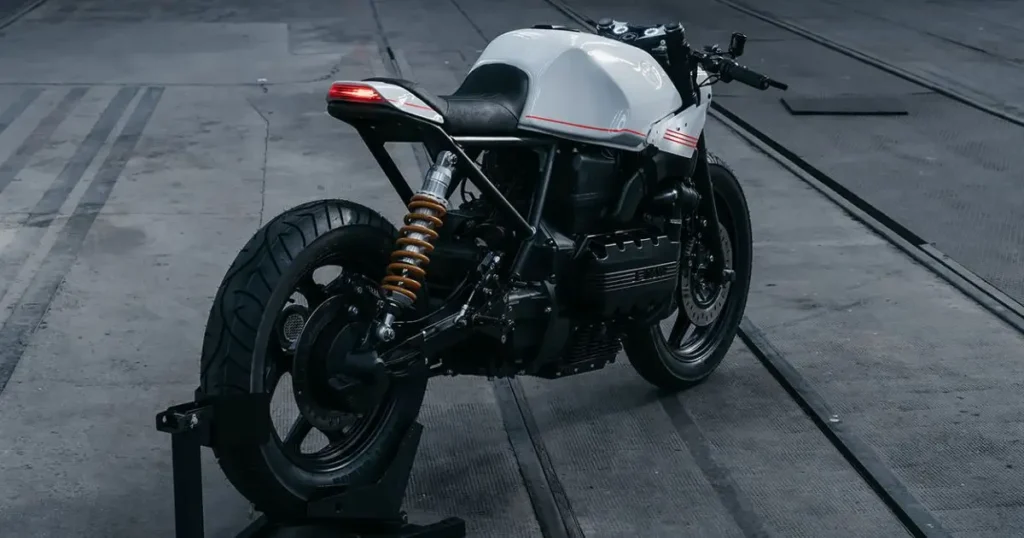
At the rear, the stock subframe was replaced with a custom unit. This new subframe was built from CNC-bent steel tubes and welded together to form a clean, strong structure. It supports the solo seat and rear cowl while maintaining a compact and balanced profile.

An Öhlins rear shock was fitted to complete the suspension upgrade. The shock was custom-built to match the geometry and weight of the finished motorcycle. It connects directly to the new subframe and provides improved support under load.
These suspension and frame changes improve overall ride quality and reinforce the clean visual flow of the build. The result is a chassis that performs well and aligns with the sharp lines of the custom kit.
Minimalist Cockpit with Premium Hardware
The cockpit of this BMW K100 café racer is built for clarity and control. Motoism and Impuls selected each component to support a clean layout and modern function. At the center is a pair of ABM clip-on handlebars, positioned lower than stock to create a more focused riding posture. A Brembo brake control unit was added to improve brake feel and match the overall performance setup.
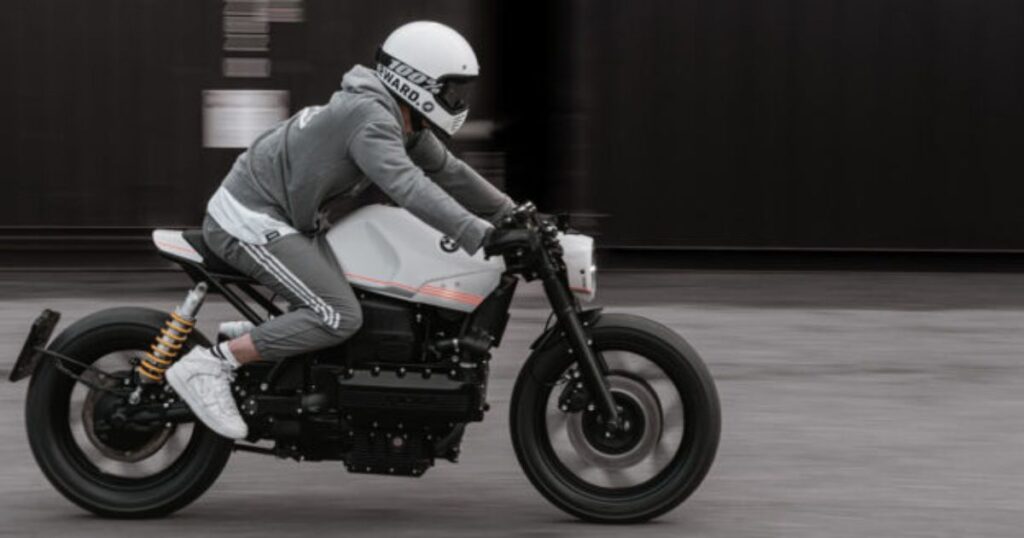
Above the handlebars, a compact Motogadget digital speedometer is mounted within the headlight nacelle. It keeps the display small and easy to read. A slim row of LED indicators sits just above the gauge, showing essential alerts such as neutral, turn signals, and system warnings.
Motoism also designed custom handlebar switches using 3D-printed housings in matte black. These units are minimal and functional, with controls for lighting, ignition, and turn signals arranged cleanly on both sides.
The ignition is managed by a hidden RFID reader. Instead of a key, the system activates when an RFID tag is placed near the sensor. This keeps the cockpit free of keyholes and reduces visual clutter.
Each element in the cockpit supports both usability and appearance. The setup is compact, precise, and aligned with the rest of the build.
Function Meets Form Below the Surface
Beneath its sharp exterior, this 1983 K100 café racer carries key performance upgrades and precision-built mechanical parts. The exhaust system has been completely reengineered. Impuls fabricated stainless steel four-into-one headers that connect to a titanium GPR muffler with a black finish. This system provides a strong exhaust note while matching the bike’s streamlined appearance.
The intake system was also updated. A custom 3D-printed intake manifold was created to suit the revised layout. It pairs with a 3D-printed battery box that holds two compact LiFePO4 batteries. These components reduce weight and help maintain a clean engine bay.
Cooling performance was improved through a custom coolant expansion tank. Impuls built this piece to match the overall design and support the revised engine flow.
Foot controls are built from a combination of ABM components and custom mounting parts by Impuls. The setup includes new linkages designed to align with the modified frame, giving smooth operation for gear shifts and braking without changing the riding position.
Every mechanical upgrade supports both performance and visual clarity. The parts are well-integrated, carefully placed, and free from unnecessary complexity.
Alpina White, Red Stripes, and Dark Contrasts
The color scheme of this 1983 BMW K100 café racer is bold and intentional. Motoism and Impuls selected BMW Alpina white as the base. This finish gives the body a clean, classic appearance while emphasizing the sharp geometry of the custom kit. The bright surface allows the 3D-printed components to stand out clearly.
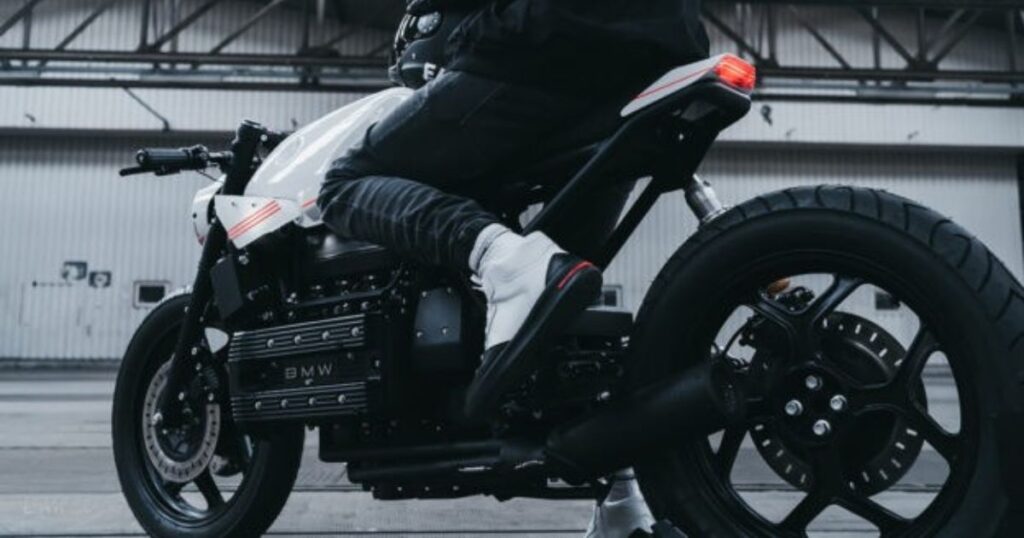
To introduce contrast, the builders added red racing stripes. These run along the body panels and create directional flow without overwhelming the form. The red accents add a motorsport-inspired touch while keeping the overall design balanced and sharp.
Below the main bodywork, the frame, engine, and suspension were coated in black. This separation helps the white upper section draw more attention and highlights the contrast between mechanical and visual elements. The result is a clear and structured appearance from every angle.
Most of the custom parts used in this project are available through Motoism’s store. These include components like the translucent wings, stainless brackets, and fork accessories. Some elements featured on the bike are not visible in final images but are available for builders who want to replicate or customize their own version.
As a unique touch, the team included a pair of color-matched sneakers designed by VOR Shoes. These reflect the project’s palette and design language, adding a subtle but personalized finish to the overall build.
A New Way to Build the K100
This custom 1983 BMW K100 café racer shows what can be achieved when modern methods meet a classic motorcycle. Motoism and Impuls moved away from traditional build techniques. They used digital scanning, 3D modeling, and additive manufacturing to shape every part of the machine. Each component was developed with clear intent. Every modification focused on improving both appearance and performance.
This project goes beyond a single motorcycle. It introduces a structured system. Many of the custom parts created for this build are available individually or as part of a full kit. This makes the process repeatable for other builders working with the K100 platform.
The final result respects the K100’s origin from the 1980s but adds a strong modern identity. The lines are sharp. The components are practical. The lighting, structure, and finishes come together to deliver a unified concept. It is not only about style. It is about process, accuracy, and vision.
For builders exploring the BMW K-series, this approach offers a clear alternative. A path based on planning and precision. The result is clean, functional, and forward-looking. A project that honors heritage while embracing the future.
Disclaimer
This article is written for informational and enthusiast purposes only. All technical details, specifications, and images are based on the original build by Motoism and Impuls. The information is taken from publicly available sources and reflects the design choices made by the builders at the time of publication. I do not have direct involvement in the creation of this motorcycle or partnership with the brands mentioned. All credit for the design, fabrication, and final build goes to the original teams, including Motoism, Impuls, and their supporting partners. Photos used belong to the credited photographer and original publishers.

